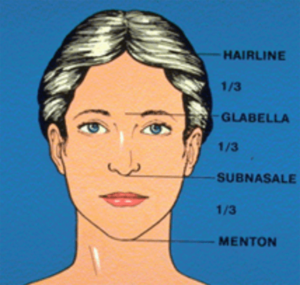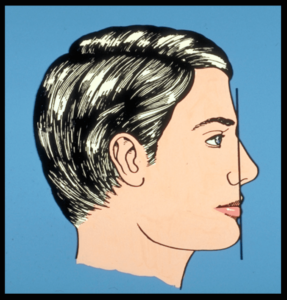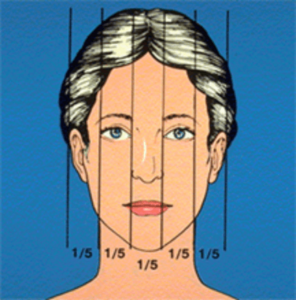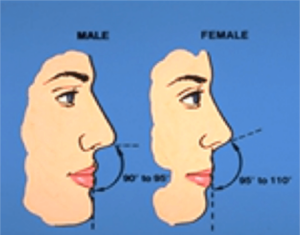
Cosmetic surgery is divided into two areas that are related by the principle: Beauty is symmetry.
The first area relates to non-proportional aspects of an individual’s face. Sometimes a facial structure is normal, but due to the size and shape of a certain area, it is not proportional to the rest of the face. Such examples include: a nose with a large hump, a chin that is too recessed, or protruding ears.
The second area relates to general aging changes may have thrown the face out of balance. Excess skin in the upper eyelids or sagging brows may make the eyes appear smaller and out of proportion. Laxity in the neck and jowl area may be making the face appear longer.
Thus, as a first step, it is important for us to analyze one’s own face.
Vertical Proportion

The face should be equal thirds in vertical height. A line drawn at the hairline, the eyebrows, at the base of the nose, and at the chin should divide the face into equal thirds.
If the upper third of the face is too long, it may be due to eyebrows sagging. This would be corrected with a endoscopic forehead or an eyebrow lift.
If the middle third of the face appears to be too long and out of proportion, it may be due to the nose being out of proportion. In this case, rhinoplasty may be indicated.
If the lower third of the face, from the nose to the chin, appears to be out of proportion, it may be due to changes in the nose, a receding chin, or excess fullness in the neck area, which makes it difficult to delineate the border of the chin. Nose surgery, chin implant surgery (mentoplasty), or surgery to contour the neck (submental lipectomy, necklift, or facelift) may be indicated.

From the profile view, a vertical line dropped from the forehead should touch the upper lip and the chin.
If the chin is too recessed, this may indicate the need for a chin implant (mentoplasty). If the chin is too protruding, retrognathic surgery to bring the chin into proportion and provide better occlusion of the teeth may be indicated.
Horizontal Proportion

Horizontally, the face should be five eye lengths wide. The width of the nose should be the width of an eye.
Increased skin in the upper eyelids may actually cause the eyes to be smaller than normal. This results in the face appearing to be wider. Drooping or sagging eyebrows can also cause the eyes to appear to be reduced in size. When this occurs, upper lid blepharoplasty and /or brow elevation procedures may be indicated.
If the nose is wider than the width of an eye, nasal surgery to reduce the flaring of the nostrils or the fullness in the tip (rhinoplasty) may be advantageous.
As we age, our tissues tend to sag. Tissues that were once in the cheekbone area actually drop down into the jowl area, giving the face a wider, and possibly longer, appearance. When this occurs, facelift surgery (rhytidectomy) can help provide more proportion and symmetry to the face.
Proportion and Symmetry

Proportion and symmetry is very important when analyzing the nose. Ideally, the distance from the tip of the nose to the base would equal the distance from the base of the nose to the upper lip. And the angle from the nose to the lip (nasolabial angle) would be between 100 – 103 degrees in men. There should be a smooth, gently sloping angle to the dorsum of the nose that serves to complement our other facial features.
.
Follow us on Facebook for more tips on health and wellness every week.
.
For information on procedures and wellness, visit our collection of free, downloadable eBooks